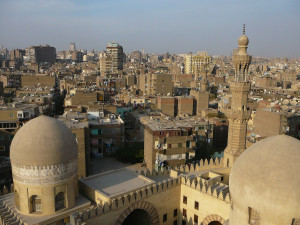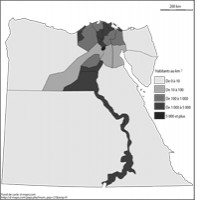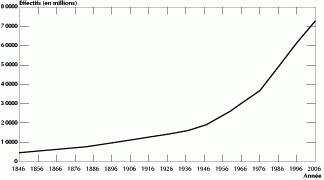Egypt, an exception in its geographical region

Egypt is one of the few Arab countries not to have really made the demographic transition, despite a fall in mortality. With nearly 79 million inhabitants in 2010, Egypt is currently the most heavily populated Arab country.
A heavily concentrated population
- More than 95% of Egypt’s population lives on a mere 5% of the country’s surface, in the Nile Delta, along the river banks of the Nile Valley, and in the immediately outlying cities of Alexandria and Port Said.
- Population density in Cairo is approximately 40,000 inhabitants per km2 (2006 figure), and in Giza it is approximately 5,300 inhabitants per km2, a much higher level than in the greater urban areas of North America and Europe such as New York and Paris.

Remarkable population growth

- From the 4.48 million people counted in 1846-1848, the Egyptian population rose to 6.83 million in 1882; a new census taken in 1897 found a population of 9.7 million.
- Over the twentieth century, the population increased by nearly 20 million, reaching 50 million inhabitants in 1986 and more than 78 million in 2010 (Source: CAPMAS).
A sharp fall in mortality
- The crude death rate fell from 17 per thousand in the early 1960s to 6 per thousand in the early 1990s.
- The infant mortality rate has fallen very sharply, from 200 per thousand in the early 1950s to 25 per thousand in 2008.
- Life expectancy at birth has risen spectacularly also, from 41 to 70 years for males and 44 to 74 years for females from 1950 to 2008.
While fertility remains high
- Though fertility was already falling in the 1960s, the number of children per woman remains high. The last official estimate of the fertility rate was 3 children in 2008. The government’s aim to have it down to the generation replacement threshold (2.1 children per woman) by 2017 thus appears unrealistic.
- The existence of family planning, the relative flexibility of religious authorities on the matter, current government policies and a new international openness are not enough to reverse the trend. Is Egyptian society ready to have smaller families?
Source: Ambrosetti Elena, 2011, Égypte, l’exception démographique, Ined, Cahiers n° 166, 256 pages [FR]
Contact: Elena Ambrosetti
Online : March 2011
